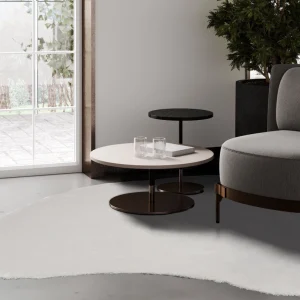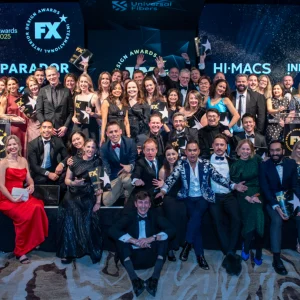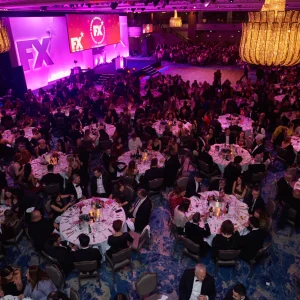Edited By Jill Entwistle
IT’S NATURAL for designers to want to push boundaries. We build on each other’s ideas and principles in a collaborative way, and we explore different techniques to bring something original and innovative to our designs. For the lighting designer, this means finding new ways to use light.
 Nulty’s 80 New Bond Street. Image Credit: James French
Nulty’s 80 New Bond Street. Image Credit: James French
Back in the beginning this wasn’t the case. Our practice was built on tangible objects, and shaped by products and the effect of light that they produce in a space. But over the years we’ve finessed our approach, and refocused our eff orts towards integration – the interplay of architecture, design and lighting design. It’s changed the way that we visualise schemes and brought about a blurring of boundaries that makes it hard to see where one discipline begins and the other ends.
 Paul Nulty is the founder of independent lighting consultant Nulty
Paul Nulty is the founder of independent lighting consultant Nulty
Logic would dictate that the advent of LED technology prompted the transition from an objective to subjective approach to design, but our work has been rooted in the art of integration for longer than we think. Designers who are old enough to remember xenon lamps will recall how they were specified for cove details, and will no doubt have used T2 compact fluorescent fittings to illuminate shelving. Th e truth is that our love affair with integration has been a slow burn; the LED revolution just ignited the flame and gave us much better tools to work with.
 Club Lounge. Image Credit: James French
Club Lounge. Image Credit: James French
As our products have become smaller and smaller, good lighting designers have jumped on this trend in all manner of weird and wonderful ways. Miniaturised light sources have made their way into columns, coves, beams, recesses and niches, as we’ve honed our craft and become adept at concealing light within the architectural features of a building.
We’ve also explored a multitude of ways to integrate light into design features such as shelves, stairways, handrails and mirrors. Working in this way creates a more free-fl owing dialogue between creatives. It’s also helped to make lighting design an integral part of the solution, not something that you bolt on as an afterthought.
Now that the trend for integration has gathered momentum, designers are becoming emboldened by the creative possibilities. We’re seeing some brilliantly ambitious concepts, where lighting design is so seamlessly embedded into a scheme that the fixtures cease to be physical products – they literally become a piece of architecture or a decorative focal point. It’s a continually evolving method of design that varies according to the creative and the context, and rests on the lighting designer’s ability to use light in a holistic way.
While integration is giving us huge scope for creativity and taking us in all kinds of directions that we never thought possible, there’s a lot more to it than making a space look pretty. It’s a collaborative process that rests on the sharing of ideas and cross-discipline expertise. It also requires you to have an almost obsessive knowledge of light because the devil is most definitely in the detail.
Integrating light into architecture requires you to understand how that space has been physically constructed. And placing a light source in a relatively small space can’t be achieved unless you understand the electrical and spatial constraints that you’re up against. You also need to be able to future-proof a design to build in provision for access and maintenance, and have a plan for what happens when a product comes off the market and needs to be replaced.
This is where a lighting designer’s expertise comes into play. Our industry has evolved since the days of those xenon lamps and fluorescent light sources. We occupy a different space today, at the nexus of architecture, design, engineering, and electronics. Th is ability to look across different fi elds and pull together the different strands of a scheme is exactly what’s required to deliver the exquisite level of detailing that goes hand in hand with a beautifully integrated project.
Bromley Old Town Hall:
Integrating the technical to focus on the decorative
 The illuminated skylight in the main hall. Image Credit: James French
The illuminated skylight in the main hall. Image Credit: James French
FOR THE restoration of the Grade II-listed Bromley Old Town Hall, we worked closely with architect Cartwright Pickard and interior design studio Fusion Interiors Group to restore the architectural significance of the historic site.
The project was first and foremost about preserving a piece of history by reinstating original luminaires found on site, but it was also about treading a fine line between authenticity and modernity. This was particularly important in the building’s new flexible co-working space, where we had to integrate solid-state solutions to elevate the performance of the meeting rooms and workspaces to that of a contemporary building.
Integration became a balancing act. We had clear repurposing goals and structural constraints to consider, and we had to find creative ways to incorporate contemporary lighting interventions, while protecting the sincerity of the aesthetic. When you walk through the main circulation areas and public spaces, the lighting design is unapologetically restrained, and your gaze is only drawn to the decorative fittings. Integration allowed us to design out technical fixtures and make the decorative lighting elements the hero of the narrative.
The building’s iconic central hall is another example of how modern light fixtures were woven into the heritage design language. We installed an artificial skylight ceiling to flood the space with light and pay homage to the 1930s skylights that were removed when the floor above was extended. The faux ceiling is inherently modern and produces dynamic white light, linked to daylight sensors, but none of this is visible to the naked eye. All you see is the symbiotic relationship between architecture and light, and a design solution that’s reverential to the legacy of the building.
Galeries Lafeyette, Shenzhen:
The scope to produce focal points
 Fitting rooms. Image Credit: Lafayette China
Fitting rooms. Image Credit: Lafayette China
IN GALERIES LAFEYETTE’S new retail space in Shenzhen, the lighting design is an integral part of the brand narrative. We took the time to consider what light was doing at every stage of the customer journey, and embedded fixtures into the decorative focal points to produce a visual tapestry of light and design.
 The gift department. Image Credit: Lafayette China
The gift department. Image Credit: Lafayette China
One of the best examples of this is how we worked with the team at interior architects Cardy Papa to make the origins of the store come through in the design. The Eiffel Tower is a recurring motif and subtly references the Parisian subtext of the brand to root the Shenzhen outpost in its heritage. We created an illuminated archway at the threshold, and elsewhere in one of the main circulation spaces, and replicated the contours of the tower through flowing lines of light.
 The double-height reception area. Image Credit: James French
The double-height reception area. Image Credit: James French
The illuminated tower is an important visual cue and stands out because of the way that light and design meet and merge. Is it a piece of artwork, or is it a lighting installation? It doesn’t really matter. What matters is the emotional response that the synergetic relationship between light and design creates. The feature draws you in, encourages you to pause, and sends you off with a strong sense of the brand.
80 New Bond Street:
Changing the visual language
 In the lobby an impressive backlit vaulted ceiling greets visitors. Image Credit: James French
In the lobby an impressive backlit vaulted ceiling greets visitors. Image Credit: James French
OCCASIONALLY A project comes along where everyone involved with the scheme works creatively and iteratively to realise the vision. In the case of 80 New Bond Street, we were brought on to the project early in the process, so the lighting was an important strand of the design from the outset, and came together through aligned thinking and careful coordination.
We worked with the architect and design lead Orms to produce a seamlessly engineered ceiling for the development’s double-height reception area. It’s a distinctively elegant aesthetic, which masks a state-of-theart lighting solution because the ceiling consists of 25 LED modules that work as a single composition of light. Everything about the ceiling feels coherent and makes sense. The vaulted soffit is slightly curved due to the way that the backlit fabric is tapered across each segment, and the modules work collectively to shift between warm and cool colour temperatures. These subtle little details pack a real punch and produce a nuanced quality of light that emulates the effect of daylight.
When designers use the term ‘lightarchitecture’ this is exactly what we’re trying to describe. As you walk into the reception area you are immersed in an ethereal quality of light, and the lines between the architecture and lighting design are entirely blurred.





